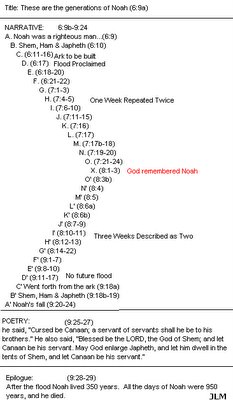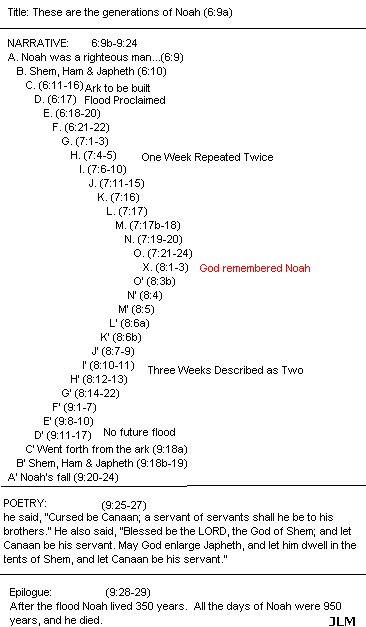 Even though Book Three is much longer than Book Two, it follows the same pattern. It begins with the title “These are the generations of Noah” (Gen 6:9). The book should focus on the descendants of Noah with such a title, but the last book did not record his death so that this book could tell us what happened in the fullness of time. The narrative section begins “Noah was a righteous man, blameless in his generation. Noah walked with God” (Gen 6:9). Thus both numbers seven and ten in the royal genealogy of Book Two’s narrative are now described as having “walked with God.” The narrative of Book Three continues until Gen 9:24. The pattern then finishes out with the poetic curse of Canaan and blessing of Shem (Gen 9:25-27) and an epilogue reminiscent of the pattern found in the royal genealogy of Book Two: “After the flood Noah lived 350 years. All the days of Noah were 950 years, and he died” (Gen 9:28-29).
Even though Book Three is much longer than Book Two, it follows the same pattern. It begins with the title “These are the generations of Noah” (Gen 6:9). The book should focus on the descendants of Noah with such a title, but the last book did not record his death so that this book could tell us what happened in the fullness of time. The narrative section begins “Noah was a righteous man, blameless in his generation. Noah walked with God” (Gen 6:9). Thus both numbers seven and ten in the royal genealogy of Book Two’s narrative are now described as having “walked with God.” The narrative of Book Three continues until Gen 9:24. The pattern then finishes out with the poetic curse of Canaan and blessing of Shem (Gen 9:25-27) and an epilogue reminiscent of the pattern found in the royal genealogy of Book Two: “After the flood Noah lived 350 years. All the days of Noah were 950 years, and he died” (Gen 9:28-29).
The narrative follows a chiastic structure natural to a flood story because of the flood rising and receding. In a chiasm the first thing said and the last thing said are parallel conceptually or thematically and the second thing said and the second to last thing said are parallel conceptually or thematically and so forth. Chiasms can be very elaborate or very simple. This one is very complicated. The Scriptures use chiasms as a way to organize stories repeatedly. Sometimes scholars have been tempted to see them where they do not exist. But this story is artificially crafted to maintain the chiasm’s structure. We know the chiasm is intentional and not just an accident of flood story-telling because on the way to the climax we see one week described two times (Gen 7:4-5 and 6-10) and in the parallel position after the climax we see three weeks described two times (Gen 8:10-11 and 12-13). The first is one week described as if two weeks by simply repeating that the rain will begin in one week (Gen 7:4 and 10). The second is a time period of three weeks described as if two weeks because there is a week that he waited before sending out the dove (Gen 8:10), he waited another seven days and again sent out the dove (Gen 8:10), and then he waited another seven days and sent forth the dove (Gen 8:12). But clearly the way it is written these three weeks sound like two weeks. So the author wants us to read the story as a chiasm. I am indebted to Tremper Longman III for this observation in his article in Inerrancy and Hermeneutic (see p.142).
The climax of a chiasm is at the center. In the flood chiasm the center is: “But God remembered Noah and all the beasts and all the livestock that were with him in the ark…” (Gen 8:1-3). The language of remembering is language for resurrection. The flood story is a death and resurrection story. But this resurrection falls short of the one it points forward to — as the narrative analogy demonstrates.
The story develops a narrative analogy or recapitulation (Sailhamer shows this) between the creation and fall narratives and the flood story. The flood is a creation-reversal. Thus when the flood recedes we see similarities with the creation story. So we see a new creation. At first the waters cover everything. Then the tops of the mountains were seen (Gen 1:9 and 8:5). The dove brings back a freshly plucked olive leaf (the earth brought forth vegetation, Gen 1:11 and 8:11). God blesses the animals and tells them to be fruitful and multiply on the earth (i.e. Gen 1:22 for birds, Gen 8:17). Man is blessed and to rule over the creation (Gen 1:28b, 9:1-2) and told that he can eat (Gen 1:29, 9:3). Man is told to be fruitful and multiply (Gen 1:28, 9:7). Adam and Noah both have three sons. Adam has Cain, Abel, and Seth (Gen 4:1-2, 25); Noah has Shem, Ham, and Japheth (Gen 9:18-19). YHWH God planted a garden for Adam (Gen 2:8) and Noah planted a vineyard (Gen 9:20).
Then we see the recapitulation of the fall narrative. Adam and Eve ate of the tree they had been commanded not to eat from (Gen 3:6) and Noah drank the wine and became drunk (Gen 9:21). Adam and Eve knew they were naked (Gen 3:7) and Noah “lay uncovered in his tent” (Gen 9:21). Adam and Eve sewed fig leaves together for aprons (Gen 3:7) and Shem and Japheth took a garment and walked backwards to cover Noah’s nakedness (Gen 9:23). And then YHWH cursed the serpent (Gen 3:14-15) and Noah cursed Canaan (Gen 9:25-27). Therefore, we learn that things before and after the fall are remarkably the same. The people still need a Savior from sin. Noah is one of many Christs (anointed ones) in Scripture who through their sin will point us to the need for Jesus. Noah’s resurrection does not change hearts. The curse still holds sway over this new creation.
To return for a moment to the subject of the narrative analogy with Genesis 1: the text, like Genesis 1, uses ANE cosmology to describe the flood. The picture is one where the deep wells up like fountains and the waters above the firmament are allowed to pour through the windows in the firmament. The firmament had been created to hold back these waters. The firmament is a hard structure to which the sun, moon, and stars are attached. In this cosmology, when one looks up in the sky and sees blue they are seeing the waters on the other side of the firmament. The author of Genesis has shown us that he knows about clouds forming and watering the earth (Gen 2:5-6 as translated by Kline) but here describes the water coming down from above with the ANE cosmology by saying the windows of the heavens were opened (Gen 7:11) and closed (Gen 8:2). We should expect the author of Genesis to do this. And this in no way demonstrates that the author is in error because the book is not teaching us science but is teaching us about God’s judgment, will, salvation, and people. It is important that the flood be considered a universal one regardless of whether it covered the whole earth or not because the text is teaching us about the final judgment that is coming for all.
So to summarize the positive teaching of the flood narrative: the great Noah falls short of the coming seed who will crush the serpent’s head. Changed hearts do not result from Noah’s resurrection. All deserve the final judgment of guilty for sin. The new creation after the flood has not escaped the effects of the curse. Thus we need the poetry.
In the overall structure of Book Three (like Books One and Two) the most important part is the poetry. Curses and blessings for future generations are immensely important in the Torah and often are the poetic text. This poem is a curse/blessing: “He said, ‘Cursed be Canaan; a servant of servants shall he be to his brothers.’ He also said, “Blessed be YHWH, the God of Shem; and let Canaan be his servant. May God enlarge Japheth, and let him dwell in the tents of Shem, and let Canaan be his servant'” (Gen 9:25-27). Thus the poem points us to the line of Shem as the line of the promise for one whose resurrection will crush the serpent’s head, reverse the curse, and begin the new creation of the heavens and earth. Israel is of the line of Shem. Thus the poetry points us to Israel as the legitimate seed of the woman and heir to the promise and ultimately points us to Jesus Christ as that seed and heir.
And the brevity of the epilogue is appropriate. Noah died.

Recent Comments